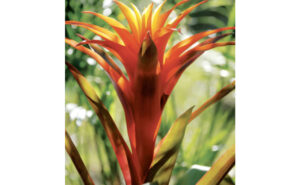
One could make the case that this Guzmania bromeliad features “axils
of evil.” (Photo: NoDerog / E+ / Getty Images)
Banking on a green resource
A pest management company called me in for a mosquito problem at a large bank in New York City. To put it mildly, the clients were very upset they had mosquitoes in their “pristine” skyscraper.
As I went through the building’s security line, the guards were happy to explain how bad the mosquitoes were and how they were experiencing numerous bites throughout the day. They said the mosquitoes were coming from the open door to the exterior and that I should check there first.
I didn’t encounter any immediate breeding sources near the door. There were no storm drains nearby, either.
My next thought was to check the elevator pits. Walking back into the lobby, I noticed a woman pushing a mobile cart and watering large potted plants about 100 feet from the security desk. She was an outside contractor who watered the plants every week.
After she moved on from the plants, I went over to inspect the pots — and got a surprise. The plants were plastic, and there was about 2 feet of standing water in each pot. As I swatted away a mosquito from my face, I saw hundreds of active mosquito larvae and pupae in each pot.
I am not making this up: Someone forgot to cancel the outside contractor and tell them the bank switched from live to artificial plants two months before.
- Solution: We drained the planters. We filled the old water areas with decorative stones. We installed two insect light traps (ILTs) near the plastic plants. I suggested an air curtain for the front entrance, but they did not go for it.
- Conclusion: Standing water is your first source for a breeding area for mosquitoes, but how it is created can be out of the ordinary. Also, we need to be patient and let clients blow off steam before we start an inspection.
Tropical ambiance causes trouble
This time, the mosquitoes were in a bank’s well-guarded money room in a sub-basement area. To enter this room, I had to go through a lobby, take an elevator, walk down a long hallway and enter through two separate, locked doors before I reached the only area where the mosquitoes were reported.
The pest control company installed two ILTs a week before I arrived. There were about 10 adult mosquitoes verified in each trap. I was looking for a sump pump area and standing water. Neither was present.
The staffers in the room kept insisting the mosquitoes came in from the exterior and somehow reached this room, maybe through an air duct. This was not the case, but I never argue with a client.
Instead, the breeding source was several Bromeliad plants installed in the money room. You could see the mosquito larvae in the axil of the leaves. Remember, like succulents, these flowering plants do not depend on a root system in the soil to obtain nutrients. Mosquitoes breed in the leaf axil, water-holding areas. Waste from mosquito larvae serves as nutrients for the plants.
- Solution: We placed about three drops of mineral oil in each axil, then inspected weekly to determine whether we needed to add more. We also maintained the ILTs that were already in place.
- Conclusion: We cannot require clients to remove their plants. They could have gone to different types of plants or even artificial ones, but they wanted the tropical look. When faced with a mosquito population without a verifiable source, we must always look for a standing water source where mosquitoes breed.
Leave A Comment